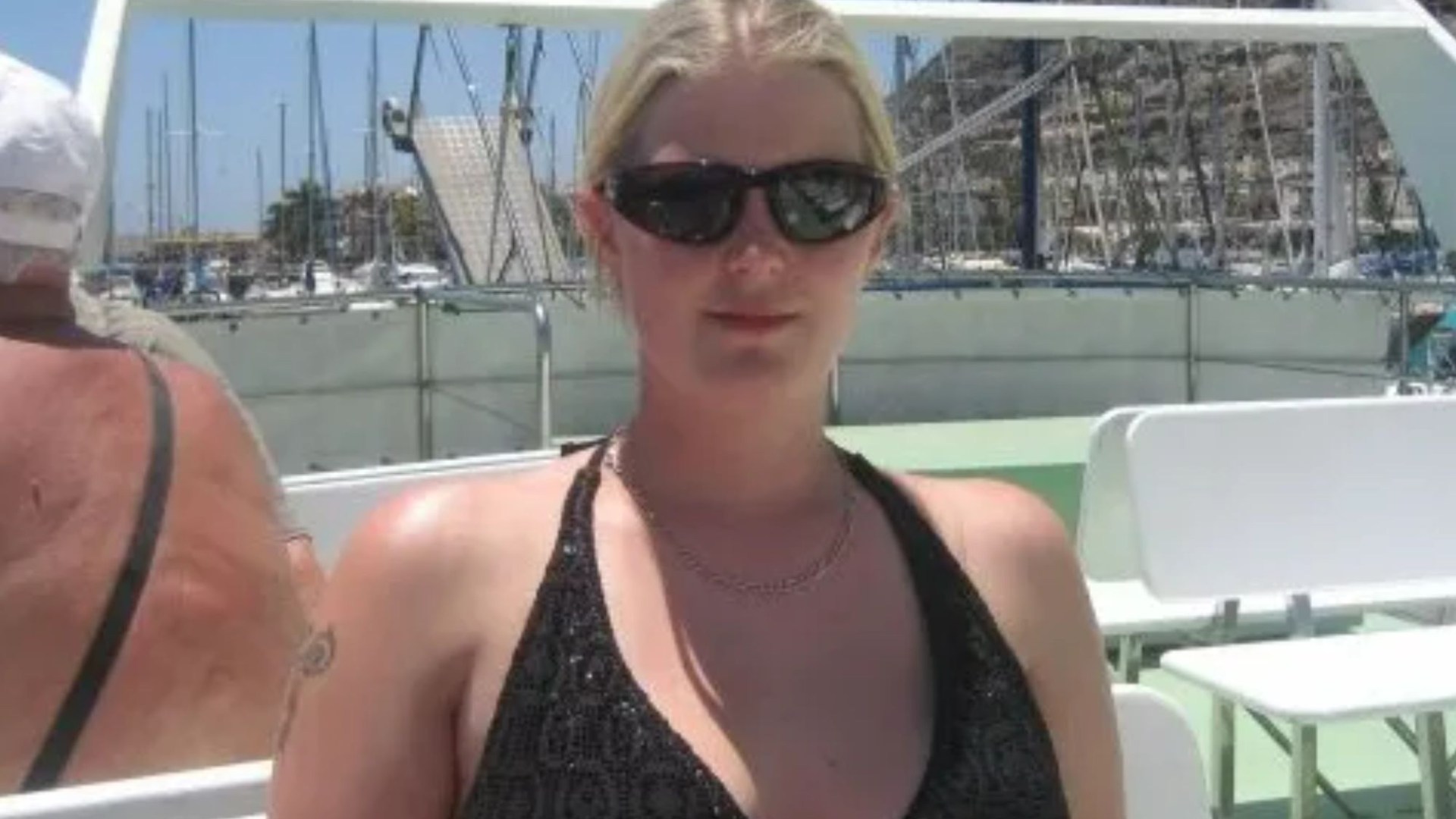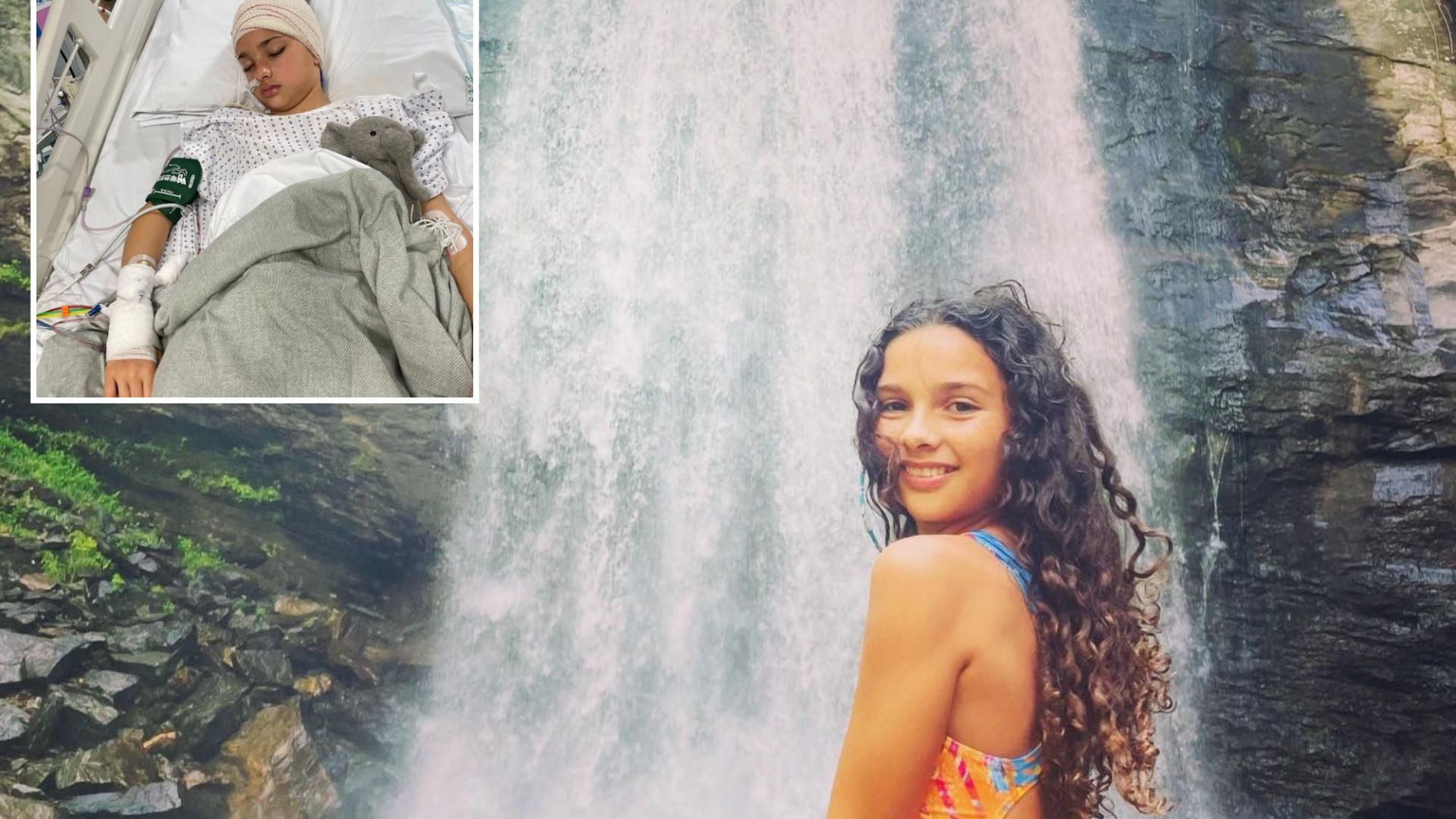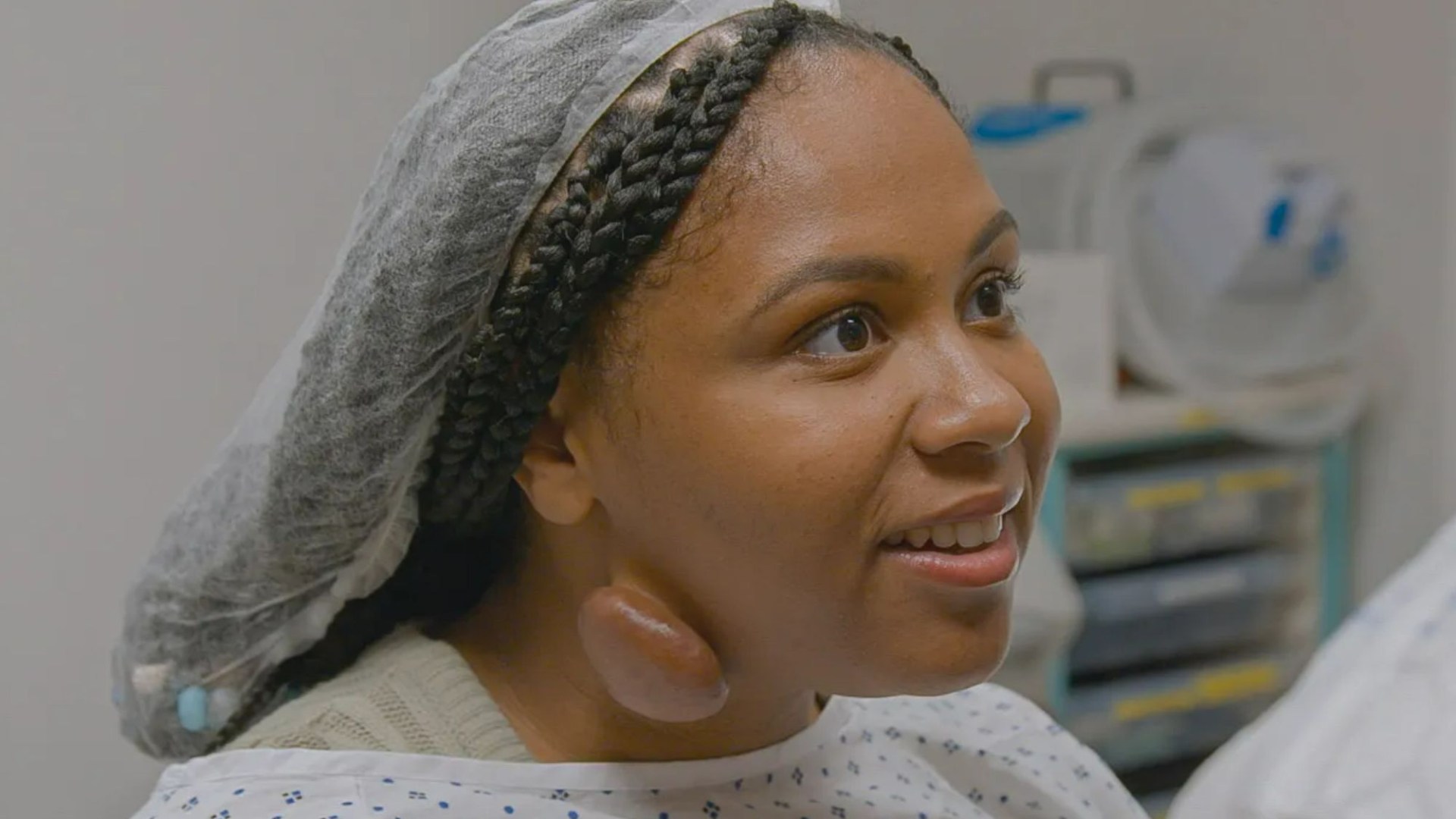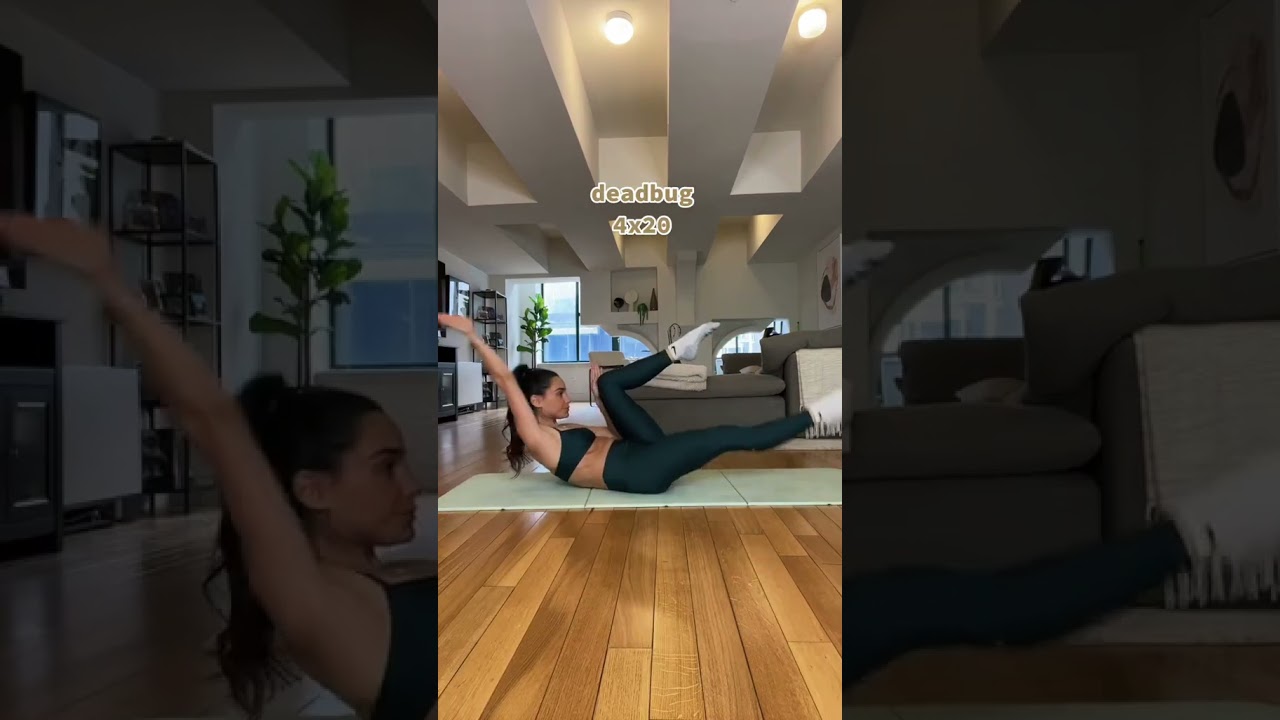Health & fitness
‘Loving’ bride-to-be, 37, found floating face down in hotel pool on ‘relaxing’ 2-week pre-wedding holiday

A BRIDE-to-be was found floating face down in a hotel swimming pool by her mum during a holiday to celebrate her upcoming nuptials.
Kirsty Earnshaw, described a “generous and loving” by her family, had travelled to the Caribbean island of St Lucia with her mum Lynn for a two-week break before tying the knot in America.
However, Kirsty would tragically never marry as she drowned in mysterious circumstances, with her mum discovering her face down in the water.
At a hearing held at Taunton Coroner’s Court, Senior Coroner Samantha Marsh blasted authorities in St Lucia for providing “scant” evidence, after three years of requests.
British authorities had requested a toxicology report, which was never provided, making inquiries into the death difficult, Mrs Marsh said.
However, the inquest did hear a statement from Kirsty’s mother, who described her daughter as “generous and really loving”, adding that she was “loved by everybody”.
More on hidden heart issues
She told police in St Lucia how the pair had planned the holiday as a half-way stop on the way to the US for Kirsty’s wedding.
They enjoyed a day by the pool on August 3, 2021, reading novels, swimming and having drinks at the bar.
Despite the drinking, Lynn said, Kirsty, 37, was aware of her surroundings and hadn’t complained of pain during the holiday.
Around 6pm Lynn returned to the poolside after briefly stepping away and was alerted by a hotel patron to “something floating in the pool”.
After realising it was Kirsty, an ambulance was called and her mother accompanied her to a local clinic.
The bride-to-be was pronounced dead, with drowning given as her cause of death.
Lynn told the inquest her daughter was a very good swimmer, and had not been taking any illegal drugs.
The inquest also heard from Kirsty’s GP practice, who gave evidence that when Kirsty first joined the surgery in 2012, she reported drinking 31 units of alcohol a week.
In later years that quantity increased to 50 units a week – equivalent to around four pints of cider a day.
However, it was noted Kirsty, of Chard, Somerset, was working to reduce her alcohol consumption, and in more recent times had abstained from drinking altogether for a period.
After Kirsty’s body was returned to the UK, British doctors examined her body but the toxicology report was said to be compromised by the embalming process.
A second post-mortem carried out at Yeovil District Hospital found no external injuries, but suggested Kirsty may have suffered from an abnormality in her heart conduction system.
The heart conduction system helps the heart contract through electrical signals to pump blood around the body.
Dr Edwin Cooper, who conducted the examination, recommended family members should undergo screening with a cardiologist in case of an inherited abnormality.
Kirsty’s father was also present at the court and described his daughter as “quite the character” and “extremely hard working” in her job as a successful chef.
He raised with the coroner that his daughter had received the Pfizer Covid vaccination two weeks prior to her death, but Mrs Marsh said there was “no evidence to suggest any link” between the vaccine and what happened.
MURKY EVIDENCE
Summing up, Mrs Marsh expressed her frustration over three years of attempting to retrieve evidence from St Lucia.
She said that efforts were still ongoing 48 hours prior to the hearing.
She said: “Regrettably, in three years of trying, that represents the totality of everything we have managed to obtain.
“I can only go where the evidence takes me. The difficulty is in this case it doesn’t take me very far.
“What we don’t have is anything meaningful by way of evidence and when Dr Cooper did get to examine the body, there had already been a disruption from one post mortem and the embalming process.
“What we do know is that events need to focus on August 2021 – Kirsty had gone on holiday to Royalton Hotel with her mum.
“This should have been a very pleasant mother daughter experience relaxing in the sunshine.
“But very sadly events took a twist and on August 3, 2021, Kirsty was discovered face down in the swimming pool.”
Arriving at her conclusion, Mrs Marsh said the evidence did not fully support any one conclusion being reached.
She added: “I simply do not know what part, if any, alcohol has played – all I can say is she got into difficulty in the water for reasons unknown.”
Hidden heart conditions
While your heart rhythm is the way your heart beats, conduction is how electrical impulses travel through your heart, which causes it to beat.
Some conduction disorders can cause arrhythmias, or irregular heartbeats.
One such condition is progressive cardiac conduction defect (PCCD), a rare inherited condition causes your heart to beat very slowly and can create problems with your heart’s rhythm.
Over time this can lead to heart block, because the heart’s electrical system is working so slowly.
Heart block means electrical signals can’t travel through your heart as they should.
PCCD can also cause abnormally fast, life-threatening rhythms by creating an electrical signal where there shouldn’t be one.
PCCD is caused by a faulty gene that can be passed down through families.
If an immediate relative has been diagnosed with PCCD, you can ask your GP to refer you to a specialist centre for inherited heart conditions.
Some people with PCCD don’t have any symptoms.
For people who do have symptoms, they can include:
- A slow pulse
- Unexplained dizziness
- Fainting and blackouts
- Shortness of breath
There’s also a small risk of sudden death if you have PCCD.
If your heart rate becomes so slow that not enough blood circulates around your body over a period of time, you could go into cardiac arrest.
A cardiac arrest usually happens without warning. If someone is in cardiac arrest, they collapse suddenly and:
- Will be unconscious
- Will be unresponsive and won’t be breathing or breathing normally – not breathing normally may mean they’re making gasping noises
If you experience symptoms such as dizziness, blackouts or shortness of breath and you think it could be linked to your heart, call your doctor.
Source: BHF
Kirsty had enjoyed a successful career as a head chef, with her father saying she was well-known for her food, in particular her talent with French cuisine.
In 2010 she was profiled by a glossy magazine when she took up the mantle of Head Chef at the Five Dials Inn in Somerset, and later worked at the up-market Dinnington Docks which was once the subject of an episode of Channel 4’s Time Team.
She was head chef there at the time of her death.
Paying tribute to Kirsty on social media, her former employer said: “Kirsty was our chef, your chef… she was our friend and yours… Kirsty was very much part of all our lives.”
Bringing the inquest to a close, Mrs Marsh apologised to the Earnshaw family that she could not bring more evidence to bear, but said it was in the interests of justice that the hearing was not delayed any further.
Womens Workouts
Day 1 – 30 MIN KILLER HIIT WORKOUT – Full Body, No Equipment, No Repeat

Here we go – DAY ONE of the GROW ADVANCED HIIT CHALLENGE!! I’m so ready to smash the next 28 days with you! Today’s home workout is focusing on working your full body, no equipment needed! The No Repeat exercises today will get your heart rate up, so you will burn Calories & Fat. Bring your energy and let’s do it!! Let’s get sweaty!
WORKOUT DETAILS
👉🏼 Duration: 30 Minutes
👉🏼 Intensity: Super Sweaty 💧💧💧
👉🏼 No Equipment
👉🏼 50 Sec Work, 10 Sec Rest
👉🏼 No Repeat
* with Cool Down Stretches
Please remember that we all are different and that you can make this your OWN workout… take a longer break when you need to.
Music: https://www.epidemicsound.com
📷 GEAR I USE:
Camera: https://amzn.to/3aticKD
Lens: https://amzn.to/3cCiujR
Tripod: https://amzn.to/2zontX9
Microphone: https://amzn.to/34VaKXH
💪🏼 MY HOME TRAINING GUIDE: http://growingannanas.com
» Subscribe to my Channel for weekly workouts: http://bit.ly/2QLvpXn
» Instagram: http://bit.ly/2ZSdHFR
» Facebook: http://bit.ly/2SVkgpE
✉ Contact (business inquiries): anna@fyndafit.com
#growingannanas #growwithanna #28dayhiitchallenge #homeworkouts #hiitworkout #workoutchallenge
D I S C L A I M E R
If you are a newbie start with a simple and easy exercise before attempting all advanced exercises. Performing exercises out of your capability might strain your muscles and you may get injured.
This channel offers health, fitness and nutritional information. You should not rely on this information as a substitute for, nor does it replace professional medical advice, diagnosis, or treatment. By performing any fitness exercises without supervision like with this video, you are performing them at your own risk. See a fitness professional to receive advice on your exercise form. Growingannanas will not be responsible or liable for any injury or harm you sustain as a result of this video.
source
Health & fitness
Girl, 12, left mute and trapped in ‘shell’ unable to walk after ‘feeling off-balance during PE’

A YOUNG girl has been left mute and unable to walk after “feeling off-balance during PE”.
Lydia Williams’ daughter Amelie, 12, who lives near Wells in Somerset, was diagnosed with medulloblastoma, aged 11, after she had an eye check-up in March 2023 and the optician noticed her eyes “flickering”.
During her athletics training, she began to notice issues with her balance.
However, it wasn’t until a routine annual check-up at the optician that some unusual symptoms were detected.
The following day, she underwent a 10-hour operation to remove an apricot-sized brain tumour.
However, when she regained consciousness, she couldn’t open her eyes for the first 24 hours and had lost the ability to walk and talk.
The removal of the tumour “caused a shock in her cerebellum” – a vital component in the brain which plays a role in motor movement regulation and balance control.
This meant that when Amelie regained consciousness after the surgery, she was experiencing posterior fossa syndrome (PFS), a complication of surgery for medulloblastoma that can cause issues with communication, motor skills, and mood.
The 12-year-old was mute for three weeks, mainly communicating through hand gestures and passing the time by listening to the Tracy Beaker audiobook series.
When she did regain some of her speech, it sounded “robotic.”
Amelie then endured six weeks of “horrific” radiotherapy, which caused her to lose her hair.
This was followed by nine months of chemotherapy and rehabilitation sessions, including physiotherapy to help her regain her movement and strength, as she spent about a year in a wheelchair in total.
Since finishing her treatment, Amelie has started secondary school for the first time on a reduced timetable as she continues to recover.
With hope and determination, she is gradually re-learning her sporting, singing, and beatboxing skills.
“(After my surgery) I couldn’t see anyone. I could sense they were there and I could hear them… but I couldn’t respond,” Amelie told PA Real Life.
She has had to relearn how to do everything again
Lydia Williams
“I felt like my body was a shell and I was trying to call out to my family, but my mouth wouldn’t move.
“When I lost my voice, it was really hard because normally I sing to express myself. If I feel sad, then I sing a song to myself.
“Now I’m going back to school and I’m doing the same clubs that I used to – going back to my gymnastics, going back to my swimming, and I’m just working on swimming techniques.”
Lydia, a 43-year-old teacher, said: “The optician said to me: ‘Just have a little look at this Mum, her eyes are doing something’.
“I had a look and they were tremoring, flickering, and I said: ‘What’s that?’
He replied: ‘I’m not sure, but I think you need to take her to the GP’.”
Amelie had a GP appointment later that day, which led to a referral to Royal United Hospital in Bath, where she underwent a series of blood tests and an MRI.
Once the scan was completed, doctors requested to speak with Lydia – and this is when she received the news that Amelie had a brain tumour, which was later confirmed as stage 4 medulloblastoma.
‘Is she going to die?’
Lydia explained: “I remember the doctor saying to me ‘Is there anything you need to know? Is there anything you want to ask us?’
Lydian asked: “Is she going to die?”
The doctor replied: “We don’t know.”
Lydia called her 50-year-old husband Chris, a yacht captain who was away at sea in Italy at the time, to inform him of the news, and Amelie was taken to Bristol Royal Infirmary via ambulance.
“She wasn’t able to talk, she wasn’t able to move, she didn’t open her eyes for the first 24 hours – she was breathing on her own, that was about it,” Lydia said.
“Ever since then, she has had to relearn how to do everything again.”
Amelie explained that she initially felt “trapped” after the surgery. Although she wanted to cry, she held back her tears, determined to stay positive.
It took Amelie three weeks to make her first sound again, and after two months, she began using words to communicate.
‘MOUNTAIN TO CLIMB’
She added: “I couldn’t talk properly like I am talking now, I was just like a robot talking, and my parents said ‘You had a tumour and the doctors had to take it out, you had cancer’.”
Although the treatment felt like “a mountain to climb,” Amelie said her family, friends, dog Dottie and the digital support groups from Young Lives vs Cancer helped her through it.
She also enjoyed visiting the two ducklings that hatched in the hospital school.
“It was agony for her, agony for me every day, and I would constantly say to her ‘Well, we’re going to go and see the ducks in a minute’, just to try and get her through that,” Lydia said.
“We used to talk about when we could walk the dog again and when we could go and lay on the field in the sunshine and smell the fresh grass – all those things that you just miss when you’re in that artificial environment.”
Gradually, with speech and language sessions along with physiotherapy, Amelie began to regain her movement and ability to talk.
Her little brother, Arlo, 10, even assisted her with some exercises at home and helped take care of her.
Since finishing her treatment in March, Amelie has continued her rehabilitation and started secondary school.
She’s also rejoined local clubs she used to attend and has been teaching herself to sing and beatbox again.
Amelie said artwork has been essential to her recovery and she would strongly advise other children with cancer to talk to “somebody that’s going through a similar thing to you” and to hold on to “hope”.
She said: “I was scared but I would always tell myself ‘Hey, it’s all going to be okay.
‘You’re going to get better and go out of the hospital and be able to do the stuff that you did before’.
“I’d like to shout out Caroline, Alban, Tia, Boheme, Aisha, and Lily, and a special thanks to my best friend Olive who has been by my side since the beginning.”
Lydia added: “I think cancer scares everybody, children and adults, and it carries with it a lot of negative connotations… but now, being a family that’s gone through something like that, I also feel that cancer isn’t the end.”
Amelie and her family were supported by the charity Young Lives vs Cancer. To find out more, visit: www.younglivesvscancer.org.uk.
What is Medulloblastoma
Medulloblastoma is a cancerous brain tumour that starts in the lower back part of the brain.
This part of the brain is called the cerebellum. It is involved in muscle coordination, balance and movement.
Medulloblastoma can happen at any age, but most often occurs in young children.
Though medulloblastoma is rare, it’s the most common cancerous brain tumour in children.
Medulloblastoma symptoms happen when the tumour grows or causes pressure to build up in the brain.
They can begin before the cancer is diagnosed and may continue for months or years even after treatment.
Signs and symptoms of medulloblastoma may include:
- Dizziness
- Double vision
- Headaches
- Nausea
- Poor coordination
- Tiredness
- Unsteady walk
- Vomiting
Source: Mayoclinic
Womens Workouts
exercise for health #video #dance #exercise #subscribe #s#shorts #youtubeshorts
Womens Workouts
30 MIN FULL BODY PILATES HIIT WORKOUT | Burn 350 Calories | Feel Strong and Balanced | No Repeat

This Pilates Fusion is a full body HIIT workout with some Pilates inspired exercises. Our focus is flexibility, mobility and creating long, lean muscles and sweating a lot to burn lots of calories. Remember stretching through the fingers, pointing the toes and keep your core engaged.I love these kind of workouts, let me know in the comments if you too!
*The number of calories you burn will vary from person to person but this might serve as a guideline.
❀Full Body Workout
❀Time: 40 sec on/ 10 sec off
Warm Up 00:00 – 03:12
Workout 03:26 – 33:13
Cool Down 33:13 – 36:21
❀ Don’t forget to Subscribe and turn on notifications so that you don’t miss any Workouts, Community Updates or Surprises:
https://www.youtube.com/channel/UC6TSBn2RAx036n04GaN6McA
❀Join the Community:
Fitness Channel
Instagram: http://instagram.com/eleni.fit__
❀ My Amazon Storefront: https://www.amazon.de/shop/elenifit
❀ Music: https://www.epidemicsound.com
DISCLAIMER
If you are new to exercise, you should understand that there is the possibility of physical injury. Please notice that if you performing any exercise or program, you agree that you do so at your own risk. This channel offers health, fitness and nutritional information and is not intended to be a substitute for professional medical advice, diagnosis or treatment.
source
Womens Workouts
new youtube workout is up now! link in bio :) #fitness #abs #workout
Health & fitness
Watch as woman, 28, plagued by giant skin growth undergoes life-changing surgery on The Bad Skin Clinic

WATCH as a woman with a massive keloid protruding from her neck finally gets the skin growth removed.
Olivia, a 28-year-old nurse, grappled with the growing keloid over the course of four years.
Starting out as a spot, it gradually swelled to the size of a satsuma and left Olivia feeling increasingly self conscious.
“It can be exhausting, trying to constantly be brave, and trying to hide it,” she said.
“It’s my face, this is what everyone sees!
“Often at the end of the day the tears may come, it makes you sad,” an emotional Olivia reflected.
Not only that, the nurse was constantly catching her seat belt or face mask on the growth, which at times became unbearably itchy.
After years of emotional and physical discomfort, Olivia decided to visit consultant dermatologist Dr Emma Craythorne about finally having the keloid removed.
The nurse’s story features in a brand new episode of The Bad Skin Clinic, as the first instalment of the seventh series airs tonight.
The new series will see Dr Craythorne help patients with a number of growths and skin ailments.
“When a skin disease affects the face it can be devastating,” the dermatologist said.
“Not just physically, but also emotionally and socially.”
Though Olivia was desperate to have her keloid removed to improve her self-confidence, the specialist nurse also visited Dr Craythorne for practical reasons.
The growth had gotten so large it has started to impact her work supporting patients with learning disabilities, as well as her everyday activities.
“My keloid… it really does get in the way. I often get my seatbelt rubbing on it.
“If I’m trying to wear masks or PPE at work, I’m quite uncomfortable with it,” the nurse explained.
Olivia’s keloid also got unbearably itchy at times, leaving her in a frenzy of scratching.
“I’m always rubbing it,” she said.
“It’s like an itch and I can’t stop doing it.”
In an initial consultation at the clinic, Dr Craythorne confirmed that Olivia’s growth was indeed a keloid.
To Olivia’s surprise, Dr Craythorne pointed out that the growth could have been triggered by something as inconspicuous as a small acne spot on her neck.
“Essentially the cells that we have responsible for making a scar are called ‘fibroblasts’,” she explained.
“If you cut yourself, or you have an injury, they start repairing that wound, and then once the injury is healed over, it stops repairing.
“But in somebody who has a tendency to keloids, those fibroblasts don’t stop making scar tissue. So in your case this a genetically-inherited tendency.
“I suspect you might have even had a spot, like an acne spot or something like that. Something really little, and that’s been enough to provoke this response.”
Olivia got yet another surprise when the dermatologist revealed that she would be able to remove through surgery that very same day.
“I know you don’t want it there, but it’s grown in such a beautiful way and does not seem to be going deep into the skin nearby,” Dr Craythorne told the nurse.
“This is a really nice keloid that should get a good outcome from surgery.”
Not expecting to go into surgery that day, Olivia was happy at the idea having the keloid removed and at the same time anxious about the surgery.
“I’m sh****** myself,” she told the dermatologist as she arrived at the theatre, prepped and ready for her op.
QUICK WORK
After injecting the keloid to numb it, Dr Craythorne started making slow and precisely incisions to the keloid with her scalped, which she told Olivia was “fairly superficial”.
“We’re not having to really dig deep down into the skin to find all the roots of it,” the dermatologist explained.
“This is where my yoga and Pilates comes into play,” she joked as she manoeuvred herself around Olivia to get to the keloid from different angles.
Dr Craythorne sliced the little “spud” all the way off before long and stitched up Olivia’s neck, asking the nurse to move her chin to make sure the skin wouldn’t pull.
What are keloid scars?
A keloid scar is a raised scar left on the skin after a wound has healed.
They usually appear a few weeks to years after damaging or injuring your skin, such as after a cut, burn or acne.
Keloid scars are usually raised, hard, smooth and shiny.
They can be skin colour, pink, red, purple, brown, or darker than the skin around them.
You’re most likely to get them on your chest, shoulders, chin, neck, ears and lower legs.
A keloid scar can grow for months or years and become bigger than the original wound.
While it’s growing, it may feel itchy or painful. This usually stops once it’s finished growing.
Speak to a GP if you think you have a keloid scar and it’s bothering you.
They may be able to improve how it looks and getting treatment early can stop the scar from growing.
Source: NHS
“Welcome to your new face,” she told a beaming Olivia, handing her a mirror.
Following the op, Dr Craythorne reflected: “When somebody has something that’s different about their face, it has an effect on them.
“Our face is so important to us in terms of communication, in terms of breathing, in terms of speaking, in terms of touch, all of these things.
“But also crucially, it’s a point of contact that people look at, so it’s not the same as having a lump growing somewhere else.
“When it’s right in the middle of your face, it has an impact in all of those ways.”
CONFIDENCE BOOST
Olivia was back at the London clinic two weeks post-op for a check-in.
“I’m just looking forward to showing Dr Emma how my face is getting on.
“Colleagues have mentioned how great things are looking, I even had someone at the chip shop say ‘ooh your thing’s gone!’,” the nurse said.
“Honestly, I feel like people are actually looking at me and talking to me as opposed to looking down at my neck,” Olivia told the dermatologist.
“My lanyard, it’s not getting stuck, it’s just sliding on…seatbelts… even like a bag, I can wear it on this side.
“Before I could never wear a bag this way. All these kinds of things, I’m so so happy,” Olivia went on.
Olivia’s surgery also boosted her self-confidence.
“I feel so pretty,” she said.
“Having it gone is literally life-changing for me. I’m so much more confident, I’m not conscious when I’m taking pictures or even when I’m walking around.
“I’m not really trying to cover my face anymore.
“My life now is amazing. I’m feeling great, really confident, really happy. Just excited for the future!”
The Bad Skin Clinic airs on Really on Tuesdays at 9pm and is available to stream on discovery+.
-

 Womens Workouts2 weeks ago
Womens Workouts2 weeks ago3 Day Full Body Women’s Dumbbell Only Workout
-

 Science & Environment3 weeks ago
Science & Environment3 weeks agoHow to unsnarl a tangle of threads, according to physics
-

 Science & Environment3 weeks ago
Science & Environment3 weeks agoHyperelastic gel is one of the stretchiest materials known to science
-

 Technology3 weeks ago
Technology3 weeks agoWould-be reality TV contestants ‘not looking real’
-

 Science & Environment3 weeks ago
Science & Environment3 weeks ago‘Running of the bulls’ festival crowds move like charged particles
-

 Science & Environment3 weeks ago
Science & Environment3 weeks agoMaxwell’s demon charges quantum batteries inside of a quantum computer
-

 News2 weeks ago
News2 weeks agoOur millionaire neighbour blocks us from using public footpath & screams at us in street.. it’s like living in a WARZONE – WordupNews
-
News3 weeks ago
the pick of new debut fiction
-

 Science & Environment3 weeks ago
Science & Environment3 weeks agoHow to wrap your mind around the real multiverse
-

 Science & Environment3 weeks ago
Science & Environment3 weeks agoQuantum ‘supersolid’ matter stirred using magnets
-

 Science & Environment3 weeks ago
Science & Environment3 weeks agoSunlight-trapping device can generate temperatures over 1000°C
-

 Science & Environment3 weeks ago
Science & Environment3 weeks agoLiquid crystals could improve quantum communication devices
-

 Science & Environment3 weeks ago
Science & Environment3 weeks agoITER: Is the world’s biggest fusion experiment dead after new delay to 2035?
-

 Science & Environment3 weeks ago
Science & Environment3 weeks agoQuantum forces used to automatically assemble tiny device
-

 Science & Environment3 weeks ago
Science & Environment3 weeks agoPhysicists are grappling with their own reproducibility crisis
-

 Science & Environment3 weeks ago
Science & Environment3 weeks agoWhy this is a golden age for life to thrive across the universe
-

 News3 weeks ago
News3 weeks agoYou’re a Hypocrite, And So Am I
-

 Sport3 weeks ago
Sport3 weeks agoJoshua vs Dubois: Chris Eubank Jr says ‘AJ’ could beat Tyson Fury and any other heavyweight in the world
-

 Science & Environment3 weeks ago
Science & Environment3 weeks agoTime travel sci-fi novel is a rip-roaringly good thought experiment
-

 Science & Environment3 weeks ago
Science & Environment3 weeks agoLaser helps turn an electron into a coil of mass and charge
-

 Science & Environment3 weeks ago
Science & Environment3 weeks agoCaroline Ellison aims to duck prison sentence for role in FTX collapse
-

 Science & Environment3 weeks ago
Science & Environment3 weeks agoNuclear fusion experiment overcomes two key operating hurdles
-
Business1 week ago
Eurosceptic Andrej Babiš eyes return to power in Czech Republic
-

 Science & Environment3 weeks ago
Science & Environment3 weeks agoNerve fibres in the brain could generate quantum entanglement
-

 Technology1 week ago
Technology1 week ago‘From a toaster to a server’: UK startup promises 5x ‘speed up without changing a line of code’ as it plans to take on Nvidia, AMD in the generative AI battlefield
-

 Football1 week ago
Football1 week agoFootball Focus: Martin Keown on Liverpool’s Alisson Becker
-

 Science & Environment3 weeks ago
Science & Environment3 weeks agoRethinking space and time could let us do away with dark matter
-

 News3 weeks ago
News3 weeks ago▶️ Hamas in the West Bank: Rising Support and Deadly Attacks You Might Not Know About
-

 Science & Environment2 weeks ago
Science & Environment2 weeks agoX-rays reveal half-billion-year-old insect ancestor
-

 MMA1 week ago
MMA1 week agoConor McGregor challenges ‘woeful’ Belal Muhammad, tells Ilia Topuria it’s ‘on sight’
-

 News3 weeks ago
News3 weeks ago▶️ Media Bias: How They Spin Attack on Hezbollah and Ignore the Reality
-
Business1 week ago
Should London’s tax exiles head for Spain, Italy . . . or Wales?
-

 Science & Environment3 weeks ago
Science & Environment3 weeks agoA slight curve helps rocks make the biggest splash
-

 News3 weeks ago
News3 weeks agoNew investigation ordered into ‘doorstep murder’ of Alistair Wilson
-

 News3 weeks ago
News3 weeks agoIsrael strikes Lebanese targets as Hizbollah chief warns of ‘red lines’ crossed
-

 Science & Environment3 weeks ago
Science & Environment3 weeks agoFuture of fusion: How the UK’s JET reactor paved the way for ITER
-

 Science & Environment3 weeks ago
Science & Environment3 weeks agoA new kind of experiment at the Large Hadron Collider could unravel quantum reality
-

 Science & Environment3 weeks ago
Science & Environment3 weeks agoUK spurns European invitation to join ITER nuclear fusion project
-

 CryptoCurrency3 weeks ago
CryptoCurrency3 weeks agoCardano founder to meet Argentina president Javier Milei
-

 News2 weeks ago
News2 weeks agoWhy Is Everyone Excited About These Smart Insoles?
-

 Science & Environment2 weeks ago
Science & Environment2 weeks agoMeet the world's first female male model | 7.30
-

 Technology2 weeks ago
Technology2 weeks agoGet ready for Meta Connect
-

 Health & fitness1 week ago
Health & fitness1 week agoThe 7 lifestyle habits you can stop now for a slimmer face by next week
-

 Science & Environment3 weeks ago
Science & Environment3 weeks agoWhy we need to invoke philosophy to judge bizarre concepts in science
-

 CryptoCurrency3 weeks ago
CryptoCurrency3 weeks agoLow users, sex predators kill Korean metaverses, 3AC sues Terra: Asia Express
-

 Womens Workouts3 weeks ago
Womens Workouts3 weeks agoBest Exercises if You Want to Build a Great Physique
-

 Womens Workouts3 weeks ago
Womens Workouts3 weeks agoEverything a Beginner Needs to Know About Squatting
-

 News2 weeks ago
News2 weeks agoFour dead & 18 injured in horror mass shooting with victims ‘caught in crossfire’ as cops hunt multiple gunmen
-

 Technology2 weeks ago
Technology2 weeks agoRobo-tuna reveals how foldable fins help the speedy fish manoeuvre
-

 Technology1 week ago
Technology1 week agoQuantum computers may work better when they ignore causality
-

 Sport1 week ago
Sport1 week agoWatch UFC star deliver ‘one of the most brutal knockouts ever’ that left opponent laid spark out on the canvas
-

 CryptoCurrency3 weeks ago
CryptoCurrency3 weeks agoEthereum is a 'contrarian bet' into 2025, says Bitwise exec
-

 Health & fitness3 weeks ago
Health & fitness3 weeks agoThe secret to a six pack – and how to keep your washboard abs in 2022
-
Business3 weeks ago
JPMorgan in talks to take over Apple credit card from Goldman Sachs
-

 Science & Environment3 weeks ago
Science & Environment3 weeks agoQuantum time travel: The experiment to ‘send a particle into the past’
-

 Science & Environment3 weeks ago
Science & Environment3 weeks agoBeing in two places at once could make a quantum battery charge faster
-

 Science & Environment3 weeks ago
Science & Environment3 weeks agoA tale of two mysteries: ghostly neutrinos and the proton decay puzzle
-

 CryptoCurrency3 weeks ago
CryptoCurrency3 weeks agoBitcoin miners steamrolled after electricity thefts, exchange ‘closure’ scam: Asia Express
-

 CryptoCurrency3 weeks ago
CryptoCurrency3 weeks agoDorsey’s ‘marketplace of algorithms’ could fix social media… so why hasn’t it?
-

 CryptoCurrency3 weeks ago
CryptoCurrency3 weeks agoDZ Bank partners with Boerse Stuttgart for crypto trading
-

 CryptoCurrency3 weeks ago
CryptoCurrency3 weeks agoBitcoin bulls target $64K BTC price hurdle as US stocks eye new record
-

 CryptoCurrency3 weeks ago
CryptoCurrency3 weeks agoBlockdaemon mulls 2026 IPO: Report
-
News3 weeks ago
The Project Censored Newsletter – May 2024
-
Politics3 weeks ago
UK consumer confidence falls sharply amid fears of ‘painful’ budget | Economics
-

 TV2 weeks ago
TV2 weeks agoCNN TÜRK – 🔴 Canlı Yayın ᴴᴰ – Canlı TV izle
-

 Science & Environment2 weeks ago
Science & Environment2 weeks agoCNN TÜRK – 🔴 Canlı Yayın ᴴᴰ – Canlı TV izle
-

 Womens Workouts2 weeks ago
Womens Workouts2 weeks ago3 Day Full Body Toning Workout for Women
-

 Servers computers2 weeks ago
Servers computers2 weeks agoWhat are the benefits of Blade servers compared to rack servers?
-

 News2 weeks ago
News2 weeks agoUS Newspapers Diluting Democratic Discourse with Political Bias
-

 Technology1 week ago
Technology1 week agoThe best robot vacuum cleaners of 2024
-

 Politics3 weeks ago
Politics3 weeks agoTrump says he will meet with Indian Prime Minister Narendra Modi next week
-

 Sport3 weeks ago
Sport3 weeks agoUFC Edmonton fight card revealed, including Brandon Moreno vs. Amir Albazi headliner
-

 Science & Environment3 weeks ago
Science & Environment3 weeks agoHow one theory ties together everything we know about the universe
-

 News3 weeks ago
News3 weeks agoBrian Tyree Henry on voicing young Megatron, his love for villain roles
-

 Health & fitness3 weeks ago
Health & fitness3 weeks agoThe maps that could hold the secret to curing cancer
-

 Technology3 weeks ago
Technology3 weeks agoThe ‘superfood’ taking over fields in northern India
-

 Science & Environment3 weeks ago
Science & Environment3 weeks agoTiny magnet could help measure gravity on the quantum scale
-

 Science & Environment3 weeks ago
Science & Environment3 weeks agoHow do you recycle a nuclear fusion reactor? We’re about to find out
-

 CryptoCurrency3 weeks ago
CryptoCurrency3 weeks agoDecentraland X account hacked, phishing scam targets MANA airdrop
-

 CryptoCurrency3 weeks ago
CryptoCurrency3 weeks agoRedStone integrates first oracle price feeds on TON blockchain
-

 CryptoCurrency3 weeks ago
CryptoCurrency3 weeks ago‘No matter how bad it gets, there’s a lot going on with NFTs’: 24 Hours of Art, NFT Creator
-
Business3 weeks ago
Thames Water seeks extension on debt terms to avoid renationalisation
-
Business3 weeks ago
How Labour donor’s largesse tarnished government’s squeaky clean image
-
Politics3 weeks ago
‘Appalling’ rows over Sue Gray must stop, senior ministers say | Sue Gray
-

 News3 weeks ago
News3 weeks agoBrian Tyree Henry on voicing young Megatron, his love for villain roles
-

 CryptoCurrency3 weeks ago
CryptoCurrency3 weeks agoCoinbase’s cbBTC surges to third-largest wrapped BTC token in just one week
-

 MMA2 weeks ago
MMA2 weeks agoRankings Show: Is Umar Nurmagomedov a lock to become UFC champion?
-

 Travel2 weeks ago
Travel2 weeks agoDelta signs codeshare agreement with SAS
-

 Politics2 weeks ago
Politics2 weeks agoHope, finally? Keir Starmer’s first conference in power – podcast | News
-
Business1 week ago
Ukraine faces its darkest hour
-

 News3 weeks ago
News3 weeks agoChurch same-sex split affecting bishop appointments
-

 Technology3 weeks ago
Technology3 weeks agoiPhone 15 Pro Max Camera Review: Depth and Reach
-

 CryptoCurrency3 weeks ago
CryptoCurrency3 weeks agoCrypto scammers orchestrate massive hack on X but barely made $8K
-

 CryptoCurrency3 weeks ago
CryptoCurrency3 weeks agoSEC asks court for four months to produce documents for Coinbase
-

 CryptoCurrency3 weeks ago
CryptoCurrency3 weeks ago‘Silly’ to shade Ethereum, the ‘Microsoft of blockchains’ — Bitwise exec
-

 Womens Workouts3 weeks ago
Womens Workouts3 weeks agoHow Heat Affects Your Body During Exercise
-

 Womens Workouts3 weeks ago
Womens Workouts3 weeks agoKeep Your Goals on Track This Season
-

 Science & Environment3 weeks ago
Science & Environment3 weeks agoSingle atoms captured morphing into quantum waves in startling image
-

 News3 weeks ago
News3 weeks agoHow FedEx CEO Raj Subramaniam Is Adapting to a Post-Pandemic Economy
-

 CryptoCurrency3 weeks ago
CryptoCurrency3 weeks agoTelegram bot Banana Gun’s users drained of over $1.9M





























You must be logged in to post a comment Login